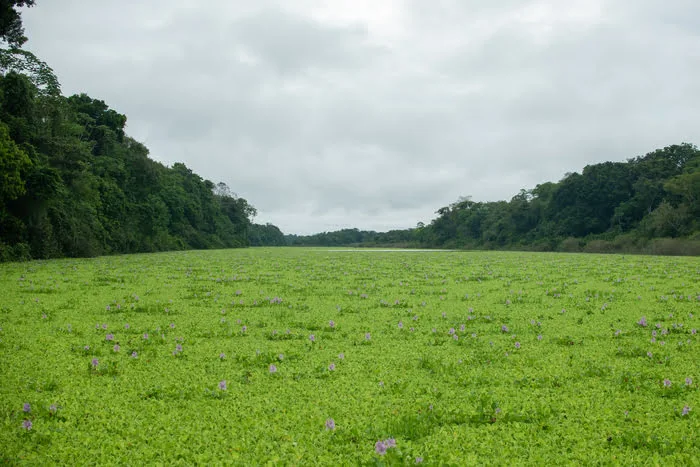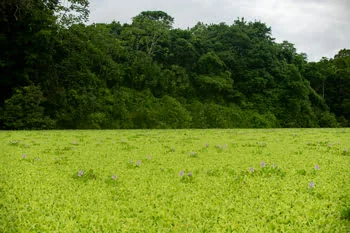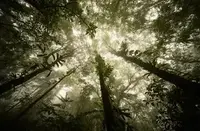Can a Floating Plant Outsmart River Currents?
Unraveling the Mysteries of Water Lettuce (Pistia stratiotes)

Nutrient Uptake and Dispersal of Water Lettuce (Pistia stratiotes) | March 3, 2025
Introduction
![Water lettuce (Pistia stratiotes). Photo By Kurt Stüber [1] - caliban.mpiz-koeln.mpg.de/mavica/index.html part of www.biolib.de, CC BY-SA 3.0, https://commons.wikimedia.org/w/index.php?curid=4890 Close up image of water lettuce (Pistia stratiotes)](https://econaturalist-assets.s3.us-east-2.amazonaws.com/images/blog/unraveling-the-mysteries-of-water-lettuce/pistia-stratiotes-closeup.webp)
Imagine a plant that floats effortlessly on the water's surface, its lush, green leaves forming a delicate rosette while its wispy, dangling roots barely touch the water below. This is water lettuce (Pistia stratiotes), a charming aquatic plant found in tropical and subtropical regions—from the winding tributaries of the Amazon to serene ponds across Asia and Africa. Unlike terrestrial plants that root firmly in nutrient-rich soils and gradually disperse seeds around them, water lettuce lives a free-floating life, absorbing dissolved nutrients directly from its watery world.
Yet herein lies a captivating mystery: How does a plant that isn’t anchored in soil secure all the nutrients it needs to thrive? And if its adult plants simply drift downstream with the current, how does water lettuce manage to colonize upriver stretches of a river system? While rooted land plants rely on a steady process of local seed dispersal and generational expansion to gradually cover new ground, water lettuce seems to defy this rule with its unusual mode of propagation.
Picture a typical land plant like an ordinary tree. The tree can drop its seeds around it. Maybe the seeds drop directly to the ground, or maybe they are dispersed a bit further away from the parent with the help of the wind. As the seeds germinate and grow into mature plants, they will then produce seeds of their own that randomly disperse even further away from the original plant. Over several generations the plant species can spread far and wide. But what about a plant like the water lettuce that is not rooted in the ground, but floats down stream. Wherever the plant releases its seeds, it will be surely down stream from where it first germantated. Furthermore, its seeds, if dropped into the water, should end up even further down stream. The water lettuce simply cannot propogate in the same method as the rooted tree can, spreading in random directions, colonizing new areas with every generation. So, how does the water lettuce end up upstream?
In this article, we explore the ingenious dispersal mechanisms that allow this floating marvel to spread upstream, challenging everything we assume about plant colonization in aquatic environments. We also delve into the fascinating strategies behind its ability to acquire nutrients without being rooted into soil.
What is Water Lettuce?

Water lettuce (Pistia stratiotes) is a free-floating aquatic plant often seen forming rosettes of velvety, ribbed leaves on the water’s surface. It floats freely without anchoring in soil, yet thrives in nutrient-rich waters by drawing sustenance directly from the water column. This species is found across tropical and subtropical regions (including the Amazon Basin) and is notorious for forming dense mats that can become invasive. Below we explore how water lettuce obtains nutrients with dangling roots and how it spreads – even reaching upriver sections of the Amazon and its tributaries.
Nutrient Absorption in Floating Water Lettuce
Water lettuce is a free-floating aquatic plant that thrives on the surface of nutrient-rich waters such as those found in the Amazon and its tributaries. Unlike terrestrial plants that obtain many of their nutrients from soil, water lettuce absorbs dissolved ions directly from the water through its extensive, dangling roots. These roots capture a range of nutrients—including nitrogen, phosphorus, potassium, calcium, magnesium, sulfur, and various trace elements (iron, manganese, copper, zinc, boron, molybdenum, and chlorine)—from the water column.
Water lettuce’s survival without soil is possible because it absorbs nutrients directly from the water through its roots (and even its leaves). The plant’s long, feathery roots hang suspended in the water, taking up dissolved minerals, nitrogen, and phosphorus from the surrounding environment[1]. In essence, it acts like a natural hydroponic system – the roots extract what the plant needs (nitrates, ammonium, phosphates, etc.) from the water itself. Studies have shown that water lettuce can significantly reduce nutrient levels in water; for example, in experiments it removed over 60% of total nitrogen from wastewater effluent[2]. Its high capacity for nutrient uptake also makes it a known hyperaccumulator – researchers have found the roots and leaves can absorb excess nutrients and even heavy metals (like zinc and cadmium) from polluted waters[1]. This efficient nutrient absorption not only feeds the plant but also often improves water quality (by stripping out nutrients that would otherwise fuel algae blooms). In summary, despite not being rooted in sediment, water lettuce meets its nutritional needs by filtering the water for dissolved nutrients using its extensive root network.
Are All Essential Nutrients Abundant in the Water?
In aquatic systems, the concentration of nutrients is not always balanced or at levels optimal for every plant. While rivers like the Amazon do carry substantial loads of dissolved nutrients—thanks to the breakdown of organic matter and input from surrounding rainforest soils—the water column often has lower concentrations of certain elements compared to nutrient-rich soils. For instance, phosphorus is frequently a limiting nutrient in aquatic environments because it tends to bind with suspended particles and sediment, making it less bioavailable[3]. Nitrogen, on the other hand, is often available in the form of nitrate or ammonium, though its levels may fluctuate seasonally or with changes in water flow.
Do Water Lettuce Plants Need Symbiotic Relationships?
Although water lettuce primarily absorbs nutrients directly from the water, emerging evidence suggests that its root surfaces may host microbial communities that facilitate nutrient uptake. These microorganisms can aid in solubilizing bound forms of nutrients—especially phosphorus—making them more accessible to the plant[4]. While water lettuce does not form the extensive mycorrhizal associations common in many terrestrial plants, its “rhizosphere” (the area around its roots) often harbors bacteria and other microbes that help convert nutrients into forms that the plant can readily absorb.
Variability in Nutrient Availability in Aquatic vs. Terrestrial Environments
There are waterways where the concentration of certain nutrients is too low for water lettuce to flourish as it does in nutrient-rich systems. For example, some clear, fast-flowing streams may have suboptimal phosphorus levels because most of the phosphorus becomes bound to sediments and is less available in the dissolved form. In such cases, rooted land plants—especially those with mycorrhizal associations—can access phosphorus stored in the soil organic matter or in mineral deposits, giving them an advantage over free-floating species like water lettuce. Conversely, in the vast, sediment-rich waters of the Amazon, water lettuce can thrive because the dissolved nutrient load is generally sufficient to support its rapid growth, even if some elements are present at lower concentrations.
Nutrient Uptake: A Dual Strategy
Water lettuce’s strategy is twofold:
- Direct Absorption: Its submerged roots extract dissolved nutrients straight from the water. This is similar to hydroponic systems, where plants rely on water as the medium for nutrient delivery.
- Microbial Assistance: The plant’s root surfaces may host beneficial microbes that help convert nutrients into forms that are more readily absorbed. Although this partnership isn’t as pronounced as the mycorrhizal relationships seen in many soil-rooted plants, it can be crucial in conditions where nutrient availability is suboptimal.
This dual strategy allows water lettuce not only to maintain high growth rates in nutrient-rich waters but also to colonize new environments—even in sections of a river system where the water is somewhat less nutrient-dense than the downstream sections.
Reproduction and Downstream Spread

Water lettuce is prolific and can multiply rapidly through two main strategies: vegetative cloning and seed production. Each plant often produces offshoots on short stolons (runners) that develop into daughter plants, creating a chain of rosettes. These easily break apart, forming new independent plants – a primary way water lettuce forms extensive mats[5]. In addition, it flowers and sets seed. The flowers are small and hidden in the leaf base, but after pollination (usually by wind or insects), water lettuce produces many tiny seeds (each fruit can contain up to about 20 seeds). These seeds mature in roughly a month and are a major mode of reproduction[5]. Once released, the seeds are dispersed by water currents; interestingly, they tend to sink into the mud or sediment of the water body, where they can lie dormant. When conditions are favorable (warm temperatures and light) the seeds germinate on the bottom and then the buoyant seedlings float back up to the surface to start new plants[5]. This adaptation allows water lettuce to survive seasonal dry periods or cold spells as seeds in the substrate, and then re-emerge when waters warm – which partly explains how infestations can reappear annually.
Floating mats and fragments naturally drift downstream with the flow of rivers, which is a common way water lettuce spreads through connected waterways. In floodplain lakes and slow-moving streams (such as those of the Amazon), mats of water lettuce can break loose and float with the current to colonize new downstream areas. In calm conditions, wind can also push the floating plants across a water body or into adjacent inlets[6]. These passive dispersal methods explain the rapid downstream invasion of water lettuce in many rivers – wherever the water flows, the plant can follow. However, the intriguing question is how water lettuce manages to appear upstream or in isolated water bodies despite its tendency to drift with currents. The answer lies in additional dispersal vectors beyond just the water flow.
Upstream Dispersal Mechanisms (Amazon Case)
Even in the vast Amazon River system, water lettuce has been observed in upriver sections and tributaries that one would think are “up-current” from existing populations. This is possible thanks to animal and human-mediated dispersal that can move water lettuce against the flow or across watershed boundaries. Scientific and ecological sources identify several key mechanisms that allow this plant to spread upriver or into new areas:
- Zoochory (Animal Dispersal): Wildlife can carry water lettuce or its propagules. Water birds and other animals often facilitate upstream spread by transporting seeds or even small plant fragments. Seeds can stick to the feathers or feet of birds, or be ingested and later excreted in distant locations. For example, studies note that seeds of water lettuce may be spread by animals such as waterfowl (even pelicans) and other mobile creatures[6]. As these birds and animals move against river flow (or between disconnected ponds), they can deposit water lettuce propagules in upstream reaches. Even semi-aquatic mammals (hippos in Africa, or analogously capybaras/manatees in the Amazon) brushing against plants might carry bits of the plant to new waters[6].
- Human Transport (Unintentional or Intentional): Human activities are a significant vector. Boat traffic on rivers can inadvertently carry water lettuce between locations – plants or seeds cling to boat hulls, propellers, fishing nets, or other gear and get released elsewhere[6]. In the Amazon, local boats moving upriver could introduce water lettuce to upstream tributaries. Additionally, the aquarium and water garden trade has historically spread water lettuce; people may release or accidentally introduce it into new waters. (In fact, water lettuce is often sold for ponds, and its introduction beyond native ranges has been partly due to human distribution.)
- Flooding and Hydrological Connections: The Amazon Basin’s flood dynamics also aid dispersal. During the wet season, extensive flooding can connect normally separate water bodies and even cause temporary reversal or slackening of currents. Floating mats of water lettuce can thus raft into upstream floodplain lakes or adjacent tributaries during high water events. When floodwaters recede, those plants may remain established in what are effectively upriver locations. In essence, floods can carry water lettuce in multiple directions, not strictly downstream, spreading it across the landscape (a pattern seen with many floating plants during Amazon floods).
- Wind and Surface Currents: In some cases, strong winds or back-eddies in river channels can push floating plants upstream or into upstream portions of slow tributaries. While not as influential as animals or humans, wind-driven surface transport can overcome mild currents on occasion, depositing water lettuce in upstream alcoves or river bends[6].
Through these mechanisms, water lettuce has managed to appear in upriver and isolated areas of the Amazon and elsewhere. Notably, historical accounts support this ability to disseminate widely. (For instance, in Florida’s St. Johns River, water lettuce was recorded over 300 km upstream from any ocean inlet in the 1700s, suggesting it was not simply washed in from the sea but had established inland[7] – likely due to natural spread and long-term presence.) Once a few individuals establish in an upriver locale, their rapid vegetative growth and prolific seeding can quickly form a new localized population.
In summary, water lettuce spreads upstream by hitchhiking on the movers of the ecosystem. Birds, animals, and human activity effectively “leapfrog” this floating plant to new waters, overcoming the limits of river flow. Combined with its high reproductive output (clonal offshoots and abundant viable seeds), these dispersal pathways allow water lettuce to invade upstream tributaries of the Amazon despite the prevailing downstream currents. Vigilant management is required to contain this species, as its nutrient-siphoning prowess and dispersal strategies make it a formidable invasive when introduced to new environments[7].
Conclusion
In conclusion, water lettuce thrives by extracting dissolved nutrients directly from the water through its extensive, dangling roots—often aided by symbiotic microbes that help solubilize essential elements like phosphorus and nitrogen. Despite its seemingly passive, free-floating nature, this plant has evolved multiple strategies to disperse upstream. Waterfowl and other animals inadvertently transport its seeds and fragments, while seasonal flooding and even human activities contribute to its unexpected colonization of upriver habitats. This remarkable combination of efficient nutrient uptake and diverse dispersal mechanisms not only enables water lettuce to flourish in nutrient-variable aquatic systems but also challenges conventional ideas about how free-floating plants can spread against the current.
Speaking of water lettuce, I've noticed that growing lettuce or any vegetables doesn't seem to be common in rainforests. I know that rainforest soils are very unfertile, but I wonder why rainforest residents don't compost their way to fertile gardens. If you'd like to read why composting the abundant vegetation in rainforests is not a miracle solution to low soil fertility read why in this article on composting for gardening in the rainforest. Or if you'd like to read more about why biological hotspots like rainforests paradoxically have poor soil fertility, check out this article on Why Are Rainforest Soils So Infertile. Or, if this article on water lettuce has inspired new questions, check out the FAQ section below!
FAQ
-
How does water temperature influence the nutrient uptake of water lettuce?
Water temperature plays a key role in regulating the metabolic rate of water lettuce, which in turn affects how efficiently it absorbs dissolved nutrients. Warmer waters tend to increase enzymatic activity, potentially enhancing nutrient uptake, while cooler temperatures may slow down these processes. Thus, seasonal temperature fluctuations can influence the overall growth and nutrient dynamics of water lettuce -
What adaptations allow water lettuce to thrive in nutrient-poor water bodies?
Even in environments where certain nutrients are scarce, water lettuce has adapted by developing highly efficient uptake systems through its extensive root network. Its ability to host beneficial microbial communities further aids in solubilizing otherwise unavailable nutrients. These adaptations allow water lettuce to extract the maximum available nutrients, even when concentrations in the water are lower than ideal. -
Are there natural predators or diseases that help regulate water lettuce populations
In its native and invaded ranges, water lettuce is subject to grazing by certain fish and waterfowl, which can help keep its population in check. Additionally, specific pathogens and fungal diseases can affect water lettuce, although these interactions are less documented compared to other invasive aquatic plants. Biological control remains an area of ongoing research to manage excessive growth in non-native habitats. -
Does water lettuce play a role in improving water quality by removing excess nutrients?
Yes, water lettuce is known for its ability to absorb large amounts of nitrogen, phosphorus, and other dissolved minerals, which can help mitigate nutrient overload in water bodies. Its nutrient uptake mechanism is one reason it is used in wastewater treatment and phytoremediation projects. However, its rapid growth can also lead to problematic mat formation if not properly managed. -
What is the typical lifespan of a water lettuce plant, and how does it affect its spread?
Water lettuce typically has a short lifespan, often only a few weeks to a couple of months, depending on environmental conditions. This rapid lifecycle, combined with its ability to reproduce both vegetatively and by seed, contributes to its potential for explosive population growth. The short lifespan means that new generations are constantly produced, facilitating ongoing dispersal. -
Can water lettuce serve as a bioindicator for water quality?
Due to its sensitivity to nutrient levels and water chemistry, water lettuce can serve as an indicator of the ecological health of an aquatic system. Changes in its growth patterns or population density may reflect shifts in water quality, such as increased nutrient pollution or changes in pH. Researchers and water managers sometimes monitor water lettuce to gauge the effectiveness of water treatment or conservation efforts. -
How do variations in river flow and flooding events influence the upstream dispersal of water lettuce?
Flooding and fluctuating river currents can create temporary hydrological connections between isolated water bodies, facilitating the dispersal of water lettuce fragments and seeds. These events can push plants into upstream areas or across tributaries that are otherwise disconnected. The erratic nature of these flows means that dispersal is somewhat opportunistic, relying on periodic high-water events to spread the plant. -
What potential ecological impacts might result from the proliferation of water lettuce in non-native habitats?
In areas where water lettuce is invasive, its rapid growth can create dense mats that block sunlight, reduce oxygen levels in the water, and alter native aquatic ecosystems. Such overgrowth can impede water flow and interfere with recreational activities, while also outcompeting native species for resources. These ecological impacts often necessitate management strategies to control its spread. -
What management strategies are available to control water lettuce in sensitive ecosystems?
Various control methods exist, including mechanical removal, biological control using herbivorous fish or insects, and even chemical treatments in severe cases. Each strategy has its benefits and challenges; for example, mechanical removal is labor-intensive, while chemical treatments must be carefully managed to avoid harming non-target species. Integrated management, combining several approaches, is often the most effective way to mitigate its spread. -
How does water lettuce compare to other free-floating aquatic plants in terms of nutrient uptake and dispersal?
Water lettuce distinguishes itself with its extensive, feather-like roots and high nutrient uptake efficiency, even in relatively nutrient-poor water. While other free-floating plants like duckweed also absorb nutrients directly from the water, water lettuce’s larger size and ability to form dense mats give it a competitive edge in certain environments. Additionally, its diverse dispersal mechanisms—including both vegetative propagation and seed production—enable it to colonize areas in ways that differ from smaller or more delicate free-floating species.
References
- Wikipedia contributors. (n.d.). Pistia. In Wikipedia, The Free Encyclopedia. Retrieved March 3, 2025, from https://en.wikipedia.org/wiki/Pistia#:~:text=As%20a%20hyper,56
- Zhao, W., Wu, H., & Chen, Z. (2018). Nutrient removal performance of water lettuce (Pistia stratiotes) and water hyacinth (Eichhornia crassipes) cultured in domestic wastewater effluent. Journal of Environmental Management, 214, 63–69. https://doi.org/10.1016/j.jenvman.2018.06.004
- Walker, T. W., & Syers, J. K. (1976). The fate of phosphorus during pedogenesis. Geoderma, 15(1), 1–19. https://doi.org/10.1016/0016-7061(76)90066-5
- Vitousek, P. M., & Sanford, R. L. (1986). Nutrient cycling in moist tropical forest. Annual Review of Ecology and Systematics, 17, 137–167. https://doi.org/10.1146/annurev.es.17.110186.001033
- U.S. Geological Survey. (n.d.). Pistia stratiotes fact sheet. Retrieved from https://nas.er.usgs.gov/queries/greatlakes/FactSheet.aspx?Species_ID=1099&Potential=Y&Type=2&HUCNumber#
- International Union for Conservation of Nature. (2012). Pathways of spread – water (Document No. 2012-048) [PDF]. Retrieved from https://portals.iucn.org/library/sites/library/files/documents/2012-048.pdf
- U.S. Fish and Wildlife Service. (n.d.). Ecological risk screening summary: Water lettuce [PDF]. Retrieved from https://www.fws.gov/sites/default/files/documents/Ecological-Risk-Screening-Summary-Water-Lettuce.pdf





